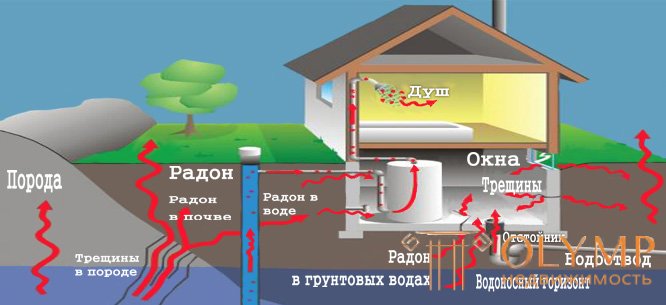
Radon gas is constantly and widely emitted from the Earth’s mass. Radon radioactivity is an integral part of the terrain's radioactive background.
Radon is formed at one of the stages of splitting of radioactive elements contained in terrestrial rocks, including those used in construction - sand, rubble, clay and other materials.
Radon is an inert gas without color and smell, 7.5 times heavier than air. Radon gives about 55-65% of the radiation dose that every inhabitant of the earth receives annually. Gas is a source of alpha radiation, which has a low penetrating power. The barrier for particles of alpha radiation can serve as a sheet of drawing paper or human skin.
Therefore, a person receives most of this dose from radionuclides that enter his body along with inhaled air. All radon isotopes are radioactive and quickly decay: the most stable isotope Rn (222) has a half-life of 3.8 days, the second most stable - the toron of Rn (220) - 55.6 seconds.
Radon, having only short-lived isotopes, does not disappear from the atmosphere, because it constantly enters it from the earth; rocks. The loss of radon is compensated by its intake, and in the atmosphere there is a certain equilibrium concentration.
For people, an unpleasant feature of radon is its property to accumulate in the premises, significantly increasing the level of radioactivity in the accumulation sites. In other words, the equilibrium concentration of radon in the room can be significantly higher than outside.
Sources of radon in the house are shown in Figure 1. The figure also shows the radon power from a particular source.
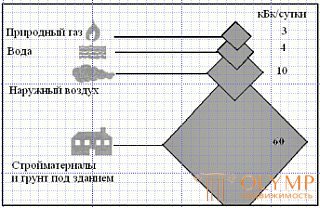 |
| Figure 1. Radiation power of various sources radon in a typical house. |
Radiation power is proportional to the amount of radon. It can be seen from the figure that the main source of radon entry into the house is building materials and the ground under the building.
Construction rules standardize indicators of the radioactivity of building materials and provide for monitoring compliance with established standards.
The amount of radon released from the soil under the building depends on many factors: the amount of radioactive elements in the earth’s mass, the crustal structure, gas permeability and water saturation of the upper layers of the earth, climatic conditions, the building structure and many others.
The highest concentration of radon in the air of residential premises is observed in winter.
A building with a gas-permeable floor can increase the radon flux coming out of the ground under the building up to 10 times compared to open ground. The increase in flow occurs due to the differential air pressure at the boundary of the ground and the premises of the building. This difference is estimated at an average of about 5 Pa and is due to two reasons: wind load on the building (vacuum occurring at the gas jet boundary) and temperature difference between the room air and air at the soil boundary (chimney effect).
Therefore, building codes prescribe the protection of buildings from radon intake from the ground under the building.
Figure 2 shows a map showing areas of potential radon hazard.
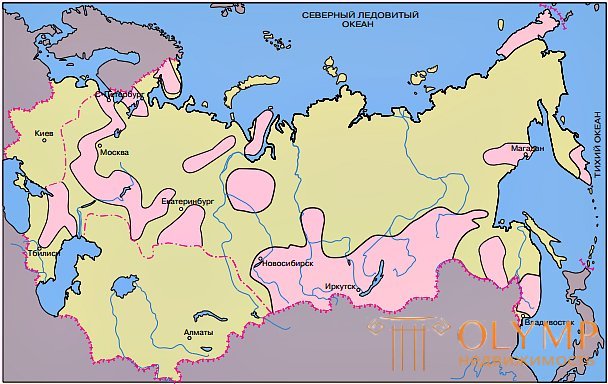 |
| Fig.2. The areas of potential danger of radon for the population are marked in pink. |
Increased release of radon in the areas indicated on the map does not occur everywhere, but in the form of foci of varying intensity and size. In other areas, it is also possible the presence of point sources of intense release of radon.
Radiation monitoring is regulated and standardized indicators:
DER gamma radiation:
- when allotting a land plot can be no more than 30 μR / hour;
EROA radon should not exceed:
- in buildings put into operation - 100 Bq / m3 (Becquerels / m3);
When land allocation is measured:
- DER of gamma radiation (gamma background);
- the content of soil erosion radon.
Radiation monitoring indicators are usually determined in pre-design surveys of the construction site. Under the current legislation, local authorities must transfer a citizen’s land for individual housing construction after radiation monitoring, provided that the indicators comply with the established sanitary standards.
When acquiring a building plot of land it is necessary to ask the owner whether radiation monitoring and its results have been carried out. In any case, a private developer, especially when the site is located in a potentially dangerous area by radon (see the map), needs to know the radiation monitoring indicators at its site.
Local district administrations should have maps of radon-hazardous areas of the region. In the absence of information, research should be ordered in local laboratories. Teaming up with neighbors, you can, as a rule, reduce the cost of these works.
Based on the results of the radon danger assessment of the construction site, measures are being taken to protect the house. The degree of radiation exposure on a person depends on the radiation power (amount of gas) and the duration of exposure.
In the case of radon, it is necessary to protect, first of all, the living quarters of the first and ground floors, where people stay for a long time.
Outbuildings and premises - basements, bathrooms, baths, garages, boiler rooms, must be protected from radon insofar as gas may penetrate from these rooms into living rooms.
To protect the residential premises of the house from radon, they arrange two lines of defense:
To reduce the entry of radon into residential floors , gas isolation (sealing) of building structures is performed. Gas isolation is usually combined with the device waterproofing underground and basement parts of the building. Such a combination does not cause difficulties, since the materials used for waterproofing are usually a barrier for gases.
A vapor barrier can also act as a barrier to radon. It should be noted that polymer films, especially plastic, radon well passed. Therefore, it is necessary to use polymer - bitumen rolled materials and mastics as a gas and hydro vapor barrier of the basement part of the building.
Gas and water insulation is usually arranged on two levels: at the border of the ground - the building and at the level of the basement.
In a house without a basement, with floors on the ground, gas and water insulation is carefully carried out at the level of first floor floor preparation structures.
Developer! Choosing options for waterproofing devices, remember the need for gas insulation of the house from radioactive radon!
High-quality gas-waterproofing is performed by gluing the structures with special waterproofing materials. The joints of rolled gas-waterproofing materials, which are laid dry, must be sealed with adhesive tape.
Gas-waterproofing of horizontal surfaces must necessarily be sealed to a similar coating of vertical structures. Particular attention is paid to the thorough sealing of the passage through the ceiling and walls of communications pipelines.
Therefore, along with gas insulation, use the ventilation system. The ventilation device, in addition, can reduce the requirements for gas insulation, which will reduce the cost of construction.
To protect against soil radon arrange exhaust ventilation of the space located under the room protected from radon. Such ventilation intercepts harmful gas on the way to the protected premises, to the barrier of gas isolation. In the space in front of the gas isolation barrier, the pressure of the gases decreases or even a vacuum zone is created, which reduces and even prevents the ingress of gas into the protected room.
This intercepting radon ventilation system is also needed because ordinary exhaust ventilation in the protected premises draws air from outside the premises, increasing the flow of radon from the ground in case of defects in gas insulation.
To protect radon from exploited basements or first floors of buildings with floors on the ground arrange exhaust ventilation of the space under the concrete floor preparation, Fig. 3
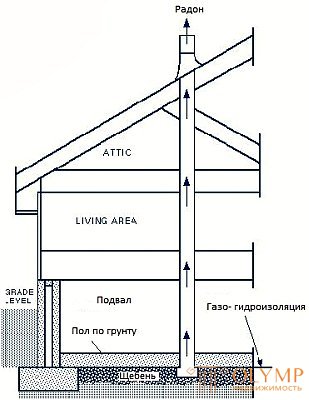 |
| Fig.3. Radon protection. Floor ventilation over the ground. |
For this purpose, a captive cushion is made under the floor with a thickness of at least 100 mm. from rubble A receiving pipe with a diameter of at least 110 mm is inserted into the cushion. ventilation duct.
A cap pillow can also be made on top of a concrete floor preparation, for example, from expanded clay, mineral wool, or another gas-permeable insulation, thereby providing floor insulation. A prerequisite in this variant is the installation of a gas-vapor barrier layer on top of the insulation.
If the basement space under the floor of the first floor is uninhabited or rarely visited, then an example of an exhaust ventilation device to protect against the first-floor radon in this case is shown in Fig.4.
 |
| Fig.4. Radon protection. Ventilation subfloor |
A layer of polymer-bitumen roll gas-waterproofing will reduce the entry of ground moisture into the underground and reduce heat loss through the ventilation system in the winter, while not reducing the effectiveness of protection against soil gases.
In some cases, there is a need to increase the efficiency of exhaust ventilation by embedding into the system of an electric fan, usually of low power (about 100 W.). Fan control can be done from the radon sensor installed in the protected area. The fan will turn on only when the radon concentration in the room is above the set value.
For a house with a total area of the first floor up to 200m2, one exhaust channel is enough.
In accordance with the sanitary standards, the content of radon in the premises must be controlled in the buildings of schools, hospitals, childcare facilities, the commissioning of residential buildings, in the production premises of enterprises.
Before you start building a house, ask about the results of radon control in the buildings closest to your site. This information may be the owners of buildings, local laboratories, carrying out measurements, Rospotrebnadzor, local design organizations.
Reducing the concentration of radon entering the protected premises from other sources: water, gas and external air is provided by conventional exhaust ventilation systems from the premises of the house.
Gas is easily adsorbed by filters with activated carbon or silica gel.
Upon completion of construction of the house, make control measurements of radon content in the premises, make sure that protection from radon ensures the safety of your family.
In Russia, the problem of protection from radon people in the buildings attended recently. Our fathers, and especially grandfathers, did not know about such a danger. Modern science claims that radonuclides of radon have a strong carcinogenic effect on human lungs.
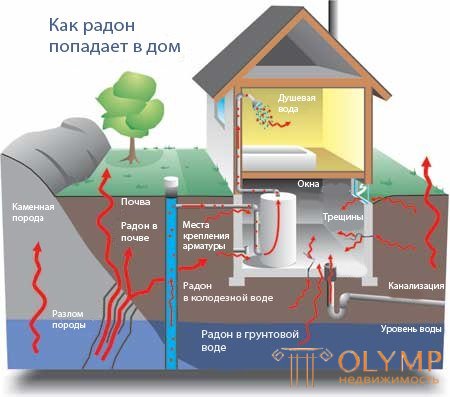
Что бы оставить комментарий войдите
Комментарии (0)